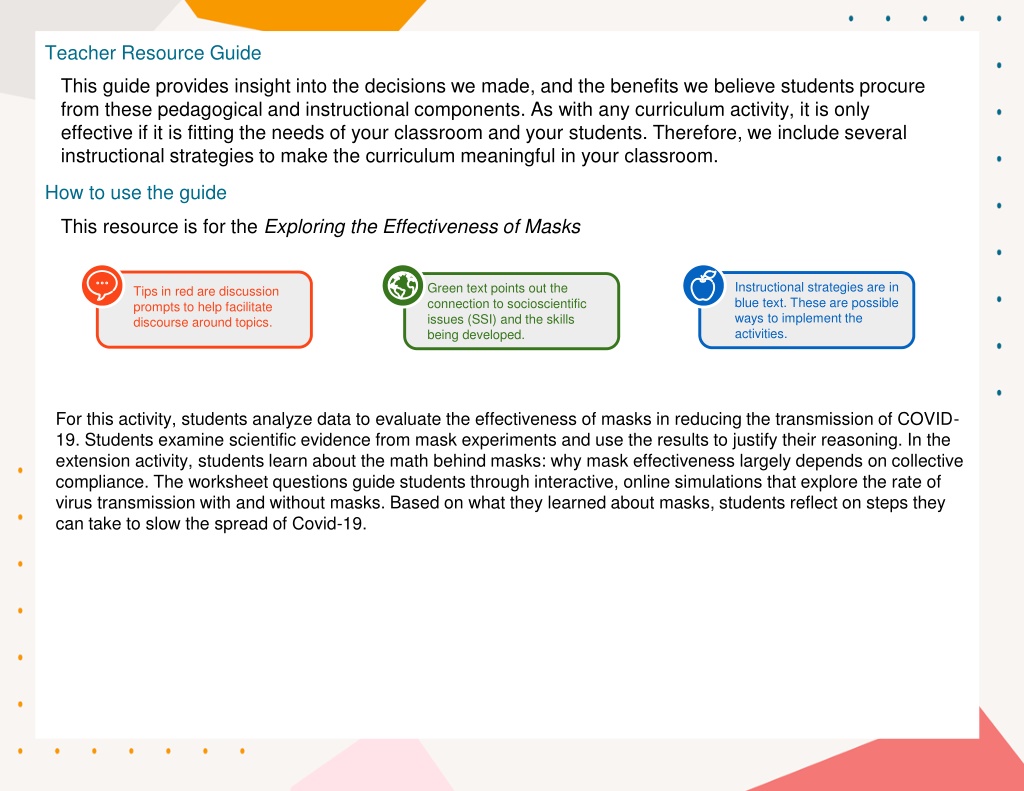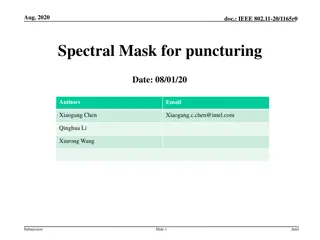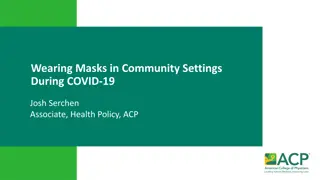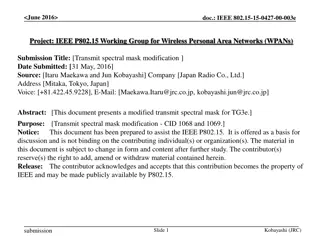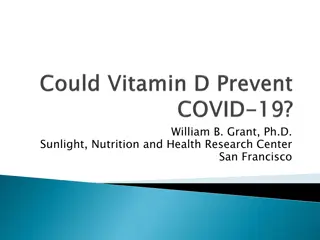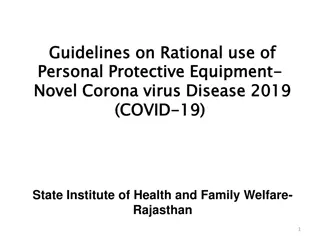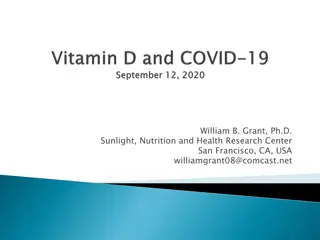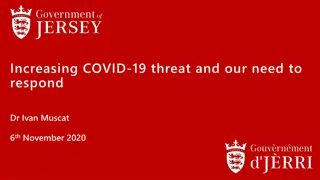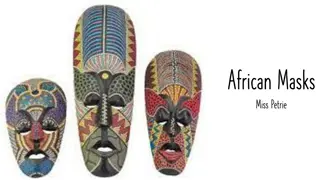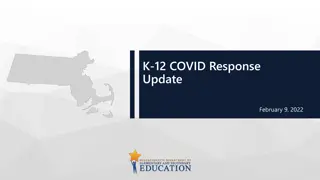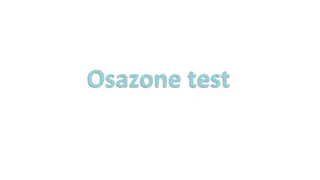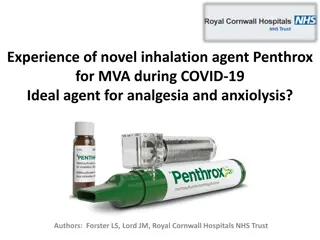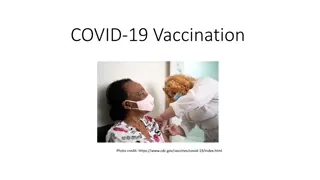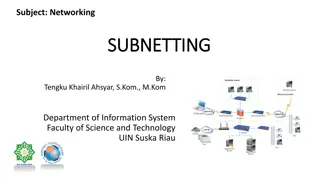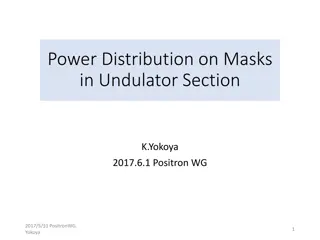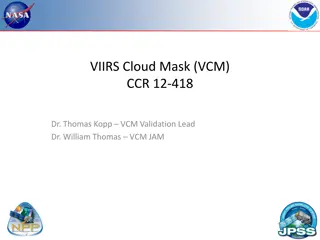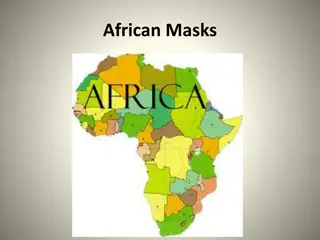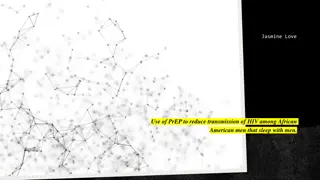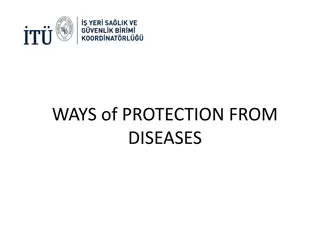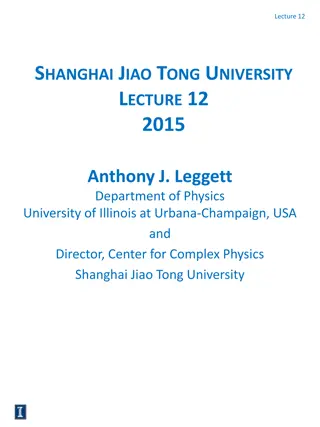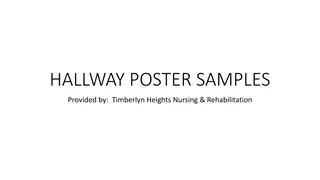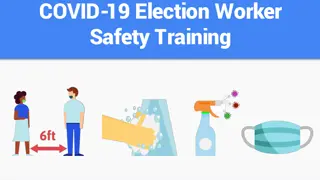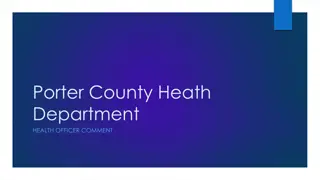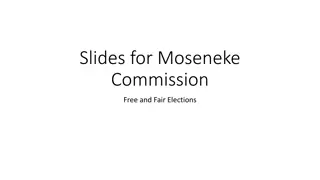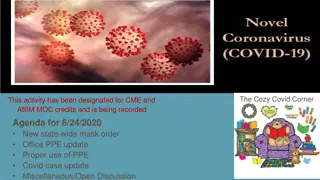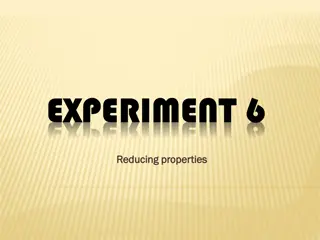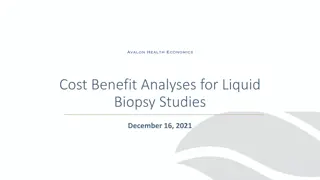Exploring Mask Effectiveness in Reducing COVID-19 Transmission
This teacher resource guide discusses activities where students analyze data on mask effectiveness in reducing COVID-19 transmission. It includes experiments, evidence, and discussions to help students make informed decisions about health safety measures. The guide provides strategies for implementing activities, linking them to socioscientific issues, and facilitating meaningful discourse. Students explore scientific evidence, reflect on steps to slow the spread of COVID-19, and learn about the math behind mask effectiveness. The guide aims to develop critical thinking skills and promote evidence-based decision-making.
Download Presentation

Please find below an Image/Link to download the presentation.
The content on the website is provided AS IS for your information and personal use only. It may not be sold, licensed, or shared on other websites without obtaining consent from the author. Download presentation by click this link. If you encounter any issues during the download, it is possible that the publisher has removed the file from their server.
E N D
Presentation Transcript
Teacher Resource Guide This guide provides insight into the decisions we made, and the benefits we believe students procure from these pedagogical and instructional components. As with any curriculum activity, it is only effective if it is fitting the needs of your classroom and your students. Therefore, we include several instructional strategies to make the curriculum meaningful in your classroom. How to use the guide This resource is for the Exploring the Effectiveness of Masks Instructional strategies are in blue text. These are possible ways to implement the activities. Green text points out the connection to socioscientific issues (SSI) and the skills being developed. Tips in red are discussion prompts to help facilitate discourse around topics. For this activity, students analyze data to evaluate the effectiveness of masks in reducing the transmission of COVID- 19. Students examine scientific evidence from mask experiments and use the results to justify their reasoning. In the extension activity, students learn about the math behind masks: why mask effectiveness largely depends on collective compliance. The worksheet questions guide students through interactive, online simulations that explore the rate of virus transmission with and without masks. Based on what they learned about masks, students reflect on steps they can take to slow the spread of Covid-19.
Learning Target: I can use evidence to explain effectiveness of different measures used to reduce the transmission of a virus. Students learn how to use scientific evidence to inform personal decision- making about health safety. Question: Why does the Center for Disease Control (CDC) recommend the use of face masks in public areas where social distancing is not possible? Claim: The CDC (Center for Disease Control) states that cloth face coverings will help prevent people who have COVID-19 from spreading the virus to others. To tie into media literacy: Can we trust these experiments? How do you know they are reliable? 1. Describe how the evidence from each experiment below supports the CDC claim. Experiment 1 (N Engl J Med. 2020 Apr 15. Visualizing Speech-Generated Oral Fluid Droplets with Laser Light Scattering) In this experiment, a man speaks the words Stay Healthy into a closed box. As exhaled droplets pass a laser light, the droplets show up as flashes and a computer counts them. After doing this 3 times, he repeats the experiment but covers his mouth with a slightly damp cloth. a) Video data from the experiment: https://www.nejm.org/doi/full/10.1056/NEJMc2007800 Evidence: This video shows that most of the droplets were blocked by cloth (qualitative data) b) The graph shows the flash count each of the 3 times the man spoke. Peaks indicate spoken words with no cloth. The number of flashes was highest (arrow) when the th sound in the word healthy was pronounced. The lower line on the graph shows the results when the speaker s mouth was covered with a cloth. Evidence: Flash count of exhaled particles when someone says Stay Healthy into a box was very high. When a cloth covered their mouth no exhaled particles were visible above the baseline count. (Quantitative)
Experiment 2 (J Med Virology. 2020 Mar 25. Potential utilities of maskwearing and instant hand hygiene for fighting SARS CoV 2 Qing Xia Ma College of Veterinary Medicine, Qingdao Agricultural University, Qingdao, China) c) In this experiment, a device was created to mimic human breathing through a mask. Avian flu virus particles were dissolved in water and nebulized to 3-5 micrometers in size. These passed into one of 4 syringes, each covered with a different mask material. One layer of polyester cloth was used as a control group. The syringes brought in air by moving the plunger in/out 100 times. This modeled standing next to someone who was very contagious for several minutes. Any virus that passed the mask was caught in a sponge, which was then tested for amount of virus using a PCR test. Table 1. Percentage of Avian Influenza Virus blocked by masks Percentage blocked (95% Confidence Interval) N95 mask 99.98% (99.98% 99.99%) Medical mask 97.14% (94.36% 98.55%) Homemade mask 95.15% (90.97% 97.39%) (made with 1 layer cloth and a 4 layer paper towel) Table 2 shows that 95% of particles were blocked by homemade cloth mask material blown through a test device, while 97% were blocked by medical masks, and nearly all virus particles were blocked by the N95. Evidence: 2. Write a CER paragraph that supports the CDC claim. Restate the claim, list the key evidence, and explain how the evidence supports the claim. Links to sample CER rubrics: 1. Rubric 1 Link 2. Rubric 2 Link Cloth face coverings will help prevent people who have COVID-19 from spreading the virus to others. CDC Claim: N95, Medical, and Homemade masks covering the mouth will block 95-99.98% of respiratory droplets Evidence: CER paragraphs is a method of synthesizing evidence from multiple experiments and negotiate complex relationships between science and health. Covid-19 is transmitted mainly by respiratory droplets from an infected person, even pre-symptomatic. Blocking droplets from an infected person will block much of the virus that enters air, reducing the chance of spreading virus to those around them Reasoning:
Extension Activity: The Math Behind Masks Face masks reduce the transmission of a virus by helping to protect both the wearer and the people around them. Widespread mask use could stop the spread of Covid-19. You will explore an interactive website that demonstrates the Multiplicative Power of Masks to answer the following questions. This extension activity requires computer access, so it can be used as a homework activity or an extensions. 1. Go to the website: https://aatishb.com/maskmath/ Watch the video Why Masks Work BETTER Than You Think Skim through the interactive essay and explore what happens when you change the simulation settings 1. Scroll to the section titled How To Stop An Epidemic (about of the page down). Find the simulation titled How Masks Reduce R0. R0 is the average number of people that a contagious person will infect. For Covid-19, R0 is about 2.5. a. Why must R0 be less than 1 to slow the spread of Covid-19? If R0 is greater than one, the infection rate grows exponentially. An R0 is less than one means that a contagious person will infect less than one person on average and the infection rate will go down. Why do I need to wear a mask if I am young and healthy? Masks not only protect yourself, but they help to protect the people around you. You can help slow the spread of Covid-19. Set R0 to 2.5. Assuming that masks are properly fitted, approximately what percentage of people need to wear masks to reduce R0to 1? You can use Table 1 in Experiment 1 from the previous activity as a reference for mask effectiveness. Answers will vary depending on mask effectiveness. If everyone was wearing homemade masks that are 95% effective, 39% of people would need to wear masks to reduce R0 to less than one. The percentage gets smaller as mask effectiveness increases. a. Students develop a sense of social responsibility by evaluating the effectiveness of collective mask wearing on the spread of Covid-19. 1. Go to the next simulation titled How Masks Reduce Infections. Let s assume that 75% of people wore masks that were 50% effective. a. Would Covid-19 be eradicated? Yes, only 74% of people need to wear masks that are 50% effective to stop the spread of Covid-19. a. Now let s assume that those same people also practiced social distancing. How would this affect R0? R0 would decrease because less people would become infected. 1. Based on what you have learned about masks, what steps can you take to slow the spread of Covid-19? Wear a mask even if you do not have Covid-19 symptoms Practice social distancing Wear properly fitted masks to improve mask effectiveness 1. Why does wearing masks need to be a collective action? If the percentage of people wearing masks increases, we can slow the spread of Covid-19 faster and even eradicate it.
